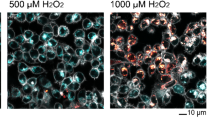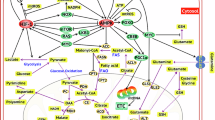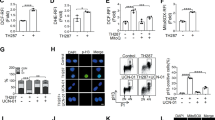Abstract
Increased aerobic glycolysis and oxidative stress are important features of cancer cell metabolism, but the underlying biochemical and molecular mechanisms remain elusive. Using a tetracycline inducible model, we show that activation of K-rasG12V causes mitochondrial dysfunction, leading to decreased respiration, elevated glycolysis, and increased generation of reactive oxygen species. The K-RAS protein is associated with mitochondria, and induces a rapid suppression of respiratory chain complex-I and a decrease in mitochondrial transmembrane potential by affecting the cyclosporin-sensitive permeability transition pore. Furthermore, pre-induction of K-rasG12V expression in vitro to allow metabolic adaptation to high glycolytic metabolism enhances the ability of the transformed cells to form tumor in vivo. Our study suggests that induction of mitochondrial dysfunction is an important mechanism by which K-rasG12V causes metabolic changes and ROS stress in cancer cells, and promotes tumor development.
Similar content being viewed by others
Log in or create a free account to read this content
Gain free access to this article, as well as selected content from this journal and more on nature.com
or
References
Warburg O . On the origin of cancer cells. Science 1956; 123:309–314.
Vander Heiden MG, Cantley LC, Thompson CB . Understanding the Warburg effect: the metabolic requirements of cell proliferation. Science 2009; 324:1029–1033.
Kaira K, Endo M, Abe M, et al. Biologic correlates of (1)F-FDG uptake on PET in pulmonary pleomorphic carcinoma. Lung Cancer 2011; 71:144–150.
Vergez S, Delord JP, Thomas F, et al. Preclinical and clinical evidence that Deoxy-2-[18F]fluoro-D-glucose positron emission tomography with computed tomography is a reliable tool for the detection of early molecular responses to erlotinib in head and neck cancer. Clin Cancer Res 2010; 16:4434–4445.
Vafa O, Wade M, Kern S, et al. c-Myc can induce DNA damage, increase reactive oxygen species, and mitigate p53 function: a mechanism for oncogene-induced genetic instability. Mol Cell 2002; 9:1031–1044.
Kim JW, Dang CV . Cancer's molecular sweet tooth and the Warburg effect. Cancer Res 2006; 66:8927–8930.
Chiaradonna F, Gaglio D, Vanoni M, Alberghina L . Expression of transforming K-Ras oncogene affects mitochondrial function and morphology in mouse fibroblasts. Biochim Biophys Acta 2006; 1757:1338–1356.
Chiaradonna F, Sacco E, Manzoni R, et al. Ras-dependent carbon metabolism and transformation in mouse fibroblasts. Oncogene 2006; 25:5391–5404.
Ramanathan A, Wang C, Schreiber SL . Perturbational profiling of a cell-line model of tumorigenesis by using metabolic measurements. Proc Natl Acad Sci USA 2005; 102:5992–5997.
Vizan P, Boros LG, Figueras A, et al. K-ras codon-specific mutations produce distinctive metabolic phenotypes in NIH3T3 mice [corrected] fibroblasts. Cancer Res 2005; 65:5512–5515.
Biaglow JE, Cerniglia G, Tuttle S, et al. Effect of oncogene transformation of rat embryo cells on cellular oxygen consumption and glycolysis. Biochem Biophys Res Commun 1997; 235:739–742.
Bos JL . ras oncogenes in human cancer: a review. Cancer Res 1989; 49:4682–4689.
Bardeesy N, DePinho RA . Pancreatic cancer biology and genetics. Nat Rev Cancer 2002; 2:897–909.
Baracca A, Chiaradonna F, Sgarbi G, et al. Mitochondrial Complex I decrease is responsible for bioenergetic dysfunction in K-ras transformed cells. Biochim Biophys Acta 2010; 1797:314–323.
Warburg O . On respiratory impairment in cancer cells. Science 1956; 124:269–270.
Degli Esposti M . Inhibitors of NADH-ubiquinone reductase: an overview. Biochim Biophys Acta 1998; 1364:222–235.
Chan TS, Teng S, Wilson JX, et al. Coenzyme Q cytoprotective mechanisms for mitochondrial complex I cytopathies involves NAD(P)H: quinone oxidoreductase 1(NQO1). Free Radic Res 2002; 36:421–427.
Pelicano H, Xu RH, Du M, et al. Mitochondrial respiration defects in cancer cells cause activation of Akt survival pathway through a redox-mediated mechanism. J Cell Biol 2006; 175:913–923.
Wolfman JC, Planchon SM, Liao J, Wolfman A . Structural and functional consequences of c-N-Ras constitutively associated with intact mitochondria. Biochim Biophys Acta 2006; 1763:1108–1124.
Bivona TG, Quatela SE, Bodemann BO, et al. PKC regulates a farnesyl-electrostatic switch on K-Ras that promotes its association with Bcl-XL on mitochondria and induces apoptosis. Mol Cell 2006; 21:481–493.
Rebollo A, Perez-Sala D, Martinez AC . Bcl-2 differentially targets K-, N-, and H-Ras to mitochondria in IL-2 supplemented or deprived cells: implications in prevention of apoptosis. Oncogene 1999; 18:4930–4939.
Grimm S, Brdiczka D . The permeability transition pore in cell death. Apoptosis 2007; 12:841–855.
Tsujimoto Y, Shimizu S . Role of the mitochondrial membrane permeability transition in cell death. Apoptosis 2007; 12:835–840.
Hlavata L, Aguilaniu H, Pichova A, Nystrom T . The oncogenic RAS2(val19) mutation locks respiration, independently of PKA, in a mode prone to generate ROS. EMBO J 2003; 22:3337–3345.
Newmeyer DD, Ferguson-Miller S . Mitochondria: releasing power for life and unleashing the machineries of death. Cell 2003; 112:481–490.
Arnold RS, Shi J, Murad E, et al. Hydrogen peroxide mediates the cell growth and transformation caused by the mitogenic oxidase Nox1. Proc Natl Acad Sci USA 2001; 98:5550–5555.
Mitsushita J, Lambeth JD, Kamata T . The superoxide-generating oxidase Nox1 is functionally required for Ras oncogene transformation. Cancer Res 2004; 64:3580–3585.
Komatsu D, Kato M, Nakayama J, Miyagawa S, Kamata T . NADPH oxidase 1 plays a critical mediating role in oncogenic Ras-induced vascular endothelial growth factor expression. Oncogene 2008; 27:4724–4732.
Mikuriya K, Kuramitsu Y, Ryozawa S, et al. Expression of glycolytic enzymes is increased in pancreatic cancerous tissues as evidenced by proteomic profiling by two-dimensional electrophoresis and liquid chromatography-mass spectrometry/mass spectrometry. Int J Oncol 2007; 30:849–855.
Trachootham D, Zhou Y, Zhang H, et al. Selective killing of oncogenically transformed cells through a ROS-mediated mechanism by beta-phenylethyl isothiocyanate. Cancer Cell 2006; 10:241–252.
Carew JS, Zhou Y, Albitar M, et al. Mitochondrial DNA mutations in primary leukemia cells after chemotherapy: clinical significance and therapeutic implications. Leukemia 2003; 17:1437–1447.
Acknowledgements
We thank Kenneth Dunner for expert technical assistance in electron microscopic analysis. This work was supported in part by grants CA085563, CA100428 and CA109041 from the National Institutes of Health.
Author information
Authors and Affiliations
Corresponding author
Additional information
( Supplementary information is linked to the online version of the paper on the Cell Research website.)
Supplementary information
Supplementary information, Figure S1
Morphological alteration of T-Rex cells after K-ras induction. (PDF 170 kb)
Supplementary information, Figure S2
Effect of K-rasG12V induction on the expression of SOD2 mRNA in HEK293 cells. (PDF 9 kb)
Supplementary information, Figure S3
Comparison of trypsin digestion of K-RAS protein in isolated mitochondria and free K-RAS in protein extracts. (PDF 21 kb)
Rights and permissions
About this article
Cite this article
Hu, Y., Lu, W., Chen, G. et al. K-rasG12V transformation leads to mitochondrial dysfunction and a metabolic switch from oxidative phosphorylation to glycolysis. Cell Res 22, 399–412 (2012). https://doi.org/10.1038/cr.2011.145
Received:
Revised:
Accepted:
Published:
Issue date:
DOI: https://doi.org/10.1038/cr.2011.145
Keywords
This article is cited by
-
Ubiquitous mitochondrial creatine kinase promotes the progression of gastric cancer through a JNK-MAPK/JUN/HK2 axis regulated glycolysis
Gastric Cancer (2023)
-
Oncogenic metabolic reprogramming in breast cancer: focus on signaling pathways and mitochondrial genes
Medical Oncology (2023)
-
Mitochondrial dysfunction and drug targets in multiple myeloma
Journal of Cancer Research and Clinical Oncology (2023)
-
Harnessing bioactive nanomaterials in modulating tumor glycolysis-associated metabolism
Journal of Nanobiotechnology (2022)
-
Tumor growth of neurofibromin-deficient cells is driven by decreased respiration and hampered by NAD+ and SIRT3
Cell Death & Differentiation (2022)



